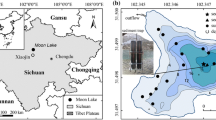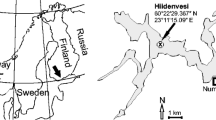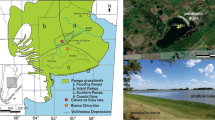Abstract
A small lake, Kaksoislammi (60° 38′30′′N, 24° 45′50′′E), in southern Finland was studied for Cladocera, diatoms and pollen from a core which covers the entire Holocene. The diatom remains indicate a steady development from alkaliphilous taxa towards the dominance of acidophilous forms and lowering pH in the late Holocene. About 1800–1700 BP, dramatic changes took place in the microfauna, mainly the planktonic Cladocera. Bosmina longirostris, the dominant species, suddenly disappeared, and Daphnia, Chydorus sphaericus and Chaoborus increased. The change is simultaneous with a decline of the diatom-inferred pH to 4.8. It is probable that there was a sudden, profound change in predator-prey relationships. The acidity of the lake water probably increased to such a low level that it led to the disappearance of even the most acid-tolerant fish. Consequently invertebrate predators increased and quickly altered the species composition in the lake. There is also pollen evidence of the onset of Iron Age cultivation and grazing almost simultaneously with the faunal change. Therefore, it cannot be ruled out that the sudden lowering of pH was indirectly caused by prehistoric human activity; possibly the acidic peatland surrounding the lake was disturbed.
Similar content being viewed by others
References
Alhonen P. 1970. On the significance of the planktonic / littoral ratio in the cladoceran stratigraphy of lake sediments. Soc. Sci. Fenn. Comm. Biol. 35: 1–9.
Behre K.-E. 1981. The interpretation of anthropogenic indicators in pollen diagrams. Pollen et Spores 23: 225–245.
Bennike O. 1998. Fossil egg sacs of Diaptomus (Crustaceae: Copepoda) in Late Quaternary lake sediments. J. Paleolim. 19: 77–79.
Bińka K., CieŚla A., Łącka B., Madeyska T., Marciniak B., Szeroczyńska K. et al. 1991. The development of Be294–1edowo Lake (Central Poland)-a palaeoecological study. Stud. Geol. Pol. 100: 1–87.
Byron E.R., Folt C.L. and Goldman C.R. 1984. Copepod and cladoceran success in an oligotrophic lake. J. Plankton Res. 6: 45–65.
Davis R.H. 1987. Paleolimnological diatom studies of acidification of lakes by acid rain: an application of Quaternary science. Quat. Sci. Rev. 6: 147–163.
de Bernardi R. and Giussani G. 1978. The effect of mass fish mortality on zooplankton structure and dynamics in a small Italian lake (Lago di Annone).Verh. Int.Ver. Limnol. 20: 1045–1048.
de Bernardi R., Giussani G. and Manca M. 1987. Cladocera: Predators and prey. Hydrobiologia 145: 225–243.
DeCosta J. and Janicki A. 1978. Population dynamics and age structure of Bosmina longirostris in an acid water impoundment. Verh. Int. Ver. Limnol. 20: 2479–2483.
Digerfeldt G. and Håkansson H. 1993. The Holocene paleolimnology of Lake Sämbosjön, Southwestern Sweden. J. Paleolim. 8: 189–210.
Donner J. 1971. Towards a stratigraphical division of the Finnish Quaternary. Soc. Sci. Fenn. Comm. Phys. Math. 41: 281–305.
Donner J. 1972. Pollen frequencies in the Flandrian sediments of Lake Vakojärvi, south Finland. Soc. Sci. Fenn. Comm. Biol. 53: 1–19.
Donner J.J., Alhonen P., Eronen M., Jungner H. and Vuorela I. 1978. Biostratigraphy and radiocarbon dating of the Holocene lake sediments of Työtjärvi and the peats in the adjoining bog Barassuo west of Lahti in southern Finland. Ann. Bot. Fennici 15: 258–280.
Fægri K. and Iversen J. 1989. Textbook of Pollen Analysis. 4th edn. J. Wiley & Sons, Chichester, USA, 328 pp.
Flössner D. 1972. Krebstiere, Crustacea, Kiemen-und Blattfüßer, Branchiopoda Fischläuse, Franchiura. Die Tierwelt Deutschlands 60. Gustav Fischer Verlag, Jena, 499 pp.
Frey D.G. 1986a. Cladocera analysis. In: Berglund B.E. (ed.), Handbook of Palaeoecology and Palaeohydrology. John Wiley & Sons, Chichester, USA, pp. 692–667.
Frey D.G. 1986b. The non-cosmopolitanism of chydorid Cladocera: implications for biogeography and evolution. In: Gore R.H. and Heck K.L. (eds), Crustacean Biogeography. Balkema, Rotter-dam, The Netherlands, pp. 237–256.
Frey D.G. 1988. Littoral and offshore communities of diatoms, cladocerans and dipterous larvae, and their interpretation in paleolimnology. J. Paleolim. 1: 179–191.
Goslar T., Ralska-Jasiewiczowa M., van Geel B., Ł;ącka B., Szeroczyńska K., Chróst L. et al. 1999. Anthropogenic changes in the sediment composition of Lake GośIąż. J. Paleolim. 22: 171–185.
Hann B.J. 1989. Methods in Quaternary ecology. No. 6. Cladocera. Geosci. Can. 16: 17–26.
Hofmann W. 1987. Cladocera in space and time: analysis of lake sediments. Hydrobiologia 145: 315–321.
Hustedt F. 1937–1939. Systematische und ökologische Unter-suchungen über den Diatomeen-Flora von Java, Bali, Sumatra. Arch. Hydrobiol. Suppl. 15–16.
Huttunen P. and Turkia J. 1990. Surface sediment diatom assem-blages and lake acidity. In: Kauppi P., Anttila P. and Kenttämies K. (eds), Acidification in Finland. Springer-Verlag, Berlin, Germany, pp. 995–1008.
Kerfoot W.C. 1977. Implications of copepod predation. Limnol. Oceanogr. 22: 316–325.
Knapp R.A., Garton J.A. and Sarnelle O. 2001. The use of egg shells to infer the historical pressure of copepods in alpine lakes. J. Paleolim. 25: 539–543.
Korhola A. and Rautio M. 2001. Cladocera and other branchiopod crustaceans. In: Smol J.P., Birks H.J.B. and Last W.M. (eds), Tracking Environmental Change using Lake Sediments: Bio-logical Techniques and Indicators. Kluwer Academic Publishers, Dordrecht, The Netherlands.
Korhola A.A. and Tikkanen M.J. 1991. Holocene development and early extreme acidification in a small hilltop lake in southern Finland. Boreas 20: 333–356.
Korsman T. 1999. Temporal and spatial trends of lake acidity in northern Sweden. J. Paleolim. 22: 1–15.
Krammer K. and Lange-Bertalot H. 1986. Süßwasserflora von Mitteleuropa. Bacillariophyceae. I. Teil: Naviculaceae. Gustav Fischer Verlag, Stuttgart, Germany, 876 pp.
Krammer K. and Lange-Bertalot H. 1988. Süßwasserflora von Mitteleuropa. Bacillariophyceae. 2. Teil: Bacillariaceae, Epi-themiaceae, Surirellaceae. Gustav FischerVerlag, Stuttgart, Ger-many, 596 pp.
Krammer K., Lange-Beralot H., Håkansson H. and Nörpel M. 1991. Süßwasserflora von Mitteleuropa. Bacillariophyceae. 3. Teil: Centrales, Fragilariaceae. Eunotiaceae. Gustav Fischer Verlag, Stuttgart, Germany, 576 pp.
Krammer K. and Lange-Bertalot H. 1991. Süßwasserflora von Mitteleuropa. Bacillariophyceae. 4. Teil: Achnanthaceae, Kritis-che Ergänzungen zu Navicula (Lineolatae) und Gomphonema Gesamtliteraturverzeichnis Teil 1–4. Gustav Fischer Verlag, Stuttgart, Germany, 436 pp.
Krause-Dellin D. and Steinberg C. 1986. Cladoceran remains as indicators of lake acidification. Hydrobiologia 143: 129–134.
Lynch M. 1980. The evolution of cladoceran life histories. Quat. Rev. Biol. 55: 23–42.
Meriläinen J. 1967. The diatom flora and the hydrogen-ion con-centration of the water. Ann. Bot. Fennici 4: 51–58.
Nilssen J.P. 1978. Selective vertebrate and invertebrate predation-some paleolimnological implications. Pol. Arch. Hydrobiol. 25: 307–320.
Nilssen J.P. and Sandøy S. 1986. Acidification history and crustacean remains: some ecological obstacles. Hydrobiologia 143: 349–354.
Nilssen J.P. and Sandøy S. 1990. Recent lake acidification and cladoceran dynamics: surface sediment and core analysis from lakes in Norway, Scotland and Sweden. Phil. Trans. R. Soc. Lond. B 327: 299–309.
Nilssen J.P., Østdahl T. and Potts W.T.W. 1984. Species replace-ments in acidified lakes: physiology, predation or competition. Res. Rep. Freshwat. Inst. Drottningholm 61: 148–153.
Prather C. and Hickman M. 2000. History of a presently slightly acidic lake in northeastern Alberta, Canada as determined through analysis of the diatom record. J. Paleolim. 24: 183–198.
Rask M. and Tuunainen P. 1990. Acid-induced changes in fish populations of small Finnish lakes. In: Kauppi P., Anttila P. and Kenttämies K. (eds), Acidification in Finland. Springer-Verlag, Berlin, Germany, pp. 911–927.
Rask M., Mannio J., Forsius M., Posch M. and Vuorinen P.J. 1995. How many fish populations in Finland are affected by acid precipitation? Envir. Biol. Fish. 42: 51–63.
Renberg I. and Hellberg T. 1982. The pH history of lakes in south-western Sweden, as calculated from the subfossil diatom flora of the sediments. Ambio 11: 30–33.
Røen U. 1968. Notes on abnormalities in freshwater Entomostraca with a description of a new subspecies, Alona affinis dentata. Vidensk. Medd. Dan. Naturh. Foren. 131: 153–159.
Sandøy S. and Nilssen J.P. 1986. A geographical survey of littoral crustacea in Norway and their use in paleolimnology. Hydro-biologia 143: 277–286.
Sarmaja-Korjonen K. 1992. Fine-interval pollen and charcoal anal-yses as tracers of early clearance periods in S. Finland. Acta. Bot. Fennica 146: 1–75.
Sarmaja-Korjonen K. 1999. Headshields of ephippial Chydorus piger Sars (Cladocera, Chydoridae) females from northern Fin-nish Lapland: a long period of gamogenesis? Hydrobiologia 390: 11–18.
Sarmaja-Korjonen K. 2001. Correlation of fluctuations in cladoceran planktonic / littoral ratio between three cores from a small lake in S. Finland-Holocene water-level changes. The Holocene 11: 53–63.
Sarmaja-Korjonen K. and Alhonen P. 1999. Cladoceran and diatom evidence of lake-level fluctuations from a Finnish lake and the effect of aquatic moss layers on microfossil assemblages. J. Paleolim. 22: 277–290.
Sarmaja-Korjonen K. and Hyvärinen H. 1999. Cladoceran and diatom stratigraphy of calcareous lake sediments from Kuusamo, NE Finland. Indications of Holocene lake-level changes. Fennia 177: 55–70.
Sarmaja-Korjonen K., Hakojärvi M. and Korhola A. 2000. Subfos-sil remains of an unknown chydorid (Anomopoda: Chydoridae) from Finland. Hydrobiologia 436: 165–169.
Siver P.A. 1999. Development of paleolimnological inference models for pH, total nitrogen and specific conductivity based on planktonic diatoms. J. Paleolim. 21: 45–59.
Stoermer E.F. and Smol J.P. 1999. The Diatoms: Applications for the Environmental and Earth Sciences. Cambridge University Press, Cambridge, USA, 484 pp.
Szeroczyńska K. 1991. Impact of prehistoric settlements on the Cladocera in the sediments of Lakes Suszek, Bledowo, and Skrzetuszewskie. Hydrobiologia 225: 105–114.
Szeroczyńska K. 1998a. Palaeolimnological investigations in Po-land based on Cladocera (Crustacea). Palaeogeogr. Palaeo climatol. Palaeoecol. 140: 335–345.
Szeroczyńska K. 1998b. Anthropogenic transformation of nine lakes in Central Poland from Mesolithic to modern times in the light of Cladocera analysis. Stud. Geol. Pol. 112: 123–165.
Tolonen K. 1978a. Effects of prehistoric man on Finnish lakes. Pol. Arch. Hydrobiol. 25: 419–421.
Tolonen K., Liukkonen M., Harjula R. and Pätilä A. 1986. Acidification of small lakes in Finland documented by sedimentary diatom and chrysophycean remains. In: Smol J.P., Battarbee R.W., Davis R.B. and Meriläinen J. (eds), Diatoms and Lake Acidity. W. Junk Publishers, Dordrecht, The Netherlands, pp. 169–198.
Tolonen M. 1978b. Palaeoecology of annually laminated sediments in Lake Ahvenainen, S. Finland. II. Human influence in the lake development. Ann. Bot. Fennici 15: 223–240.
Uimonen-Simola P. and Tolonen K. 1987. Effects of recent acidifi-cation on Cladocera in small clear-water lakes studied by means of sedimentary remains. Hydrobiologia 145: 343–351.
Uutala A.J. 1990. Chaoborus (Diptera: Chaoboridae) mandibles-paleolimnological indicators of the historical status of fish populations in acid-sensitive lakes. J. Paleolim. 4: 139–151.
Uutala A.J. and Smol J.P. 1996. Paleolimnological reconstructions of long-term changes in fisheries status in Sudbury area lakes. Can. J. Fish. aquat. Sci. 53: 174–180.
Uutala A.J., Yan N.D., Dixit A.S., Dixit S.S. and Smol J.P. 1994. Paleolimnological assessment of damage to fish communities in three acidic, Canadian Shield lakes. Fish. Res. 19: 157–177.
von Ende C.N. and Dempsey D.O. 1981. Apparent exclusion of the cladoceran Bosmina longiorostris by invertebrate predator Cha-oborus americanus. Am. Midl. Natural. 105: 240–248.
Vuorela I. 1986. Palynological and historical evidence of slash-and burn civilization in South Finland. In: Behre K.-E. (ed.), An-trhopogenic Indicators in Pollen Diagrams. Balkema, Rotterdam, The Netherlands, pp. 53–64.
Author information
Authors and Affiliations
Rights and permissions
About this article
Cite this article
Sarmaja-Korjonen, K. Multi-proxy data from Kaksoislammi Lake in Finland: dramatic changes in the late Holocene cladoceran assemblages. Journal of Paleolimnology 28, 287–296 (2002). https://doi.org/10.1023/A:1021611225821
Issue Date:
DOI: https://doi.org/10.1023/A:1021611225821




